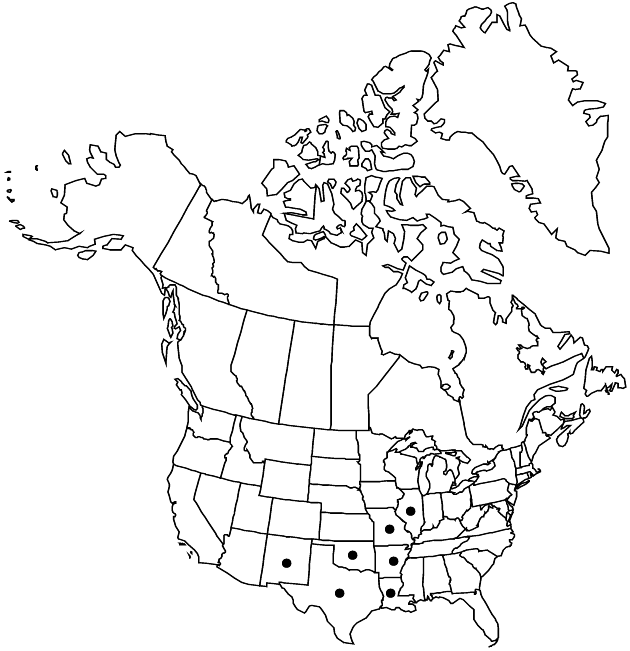Difference between revisions of "Gutierrezia texana"
Fl. N. Amer. 2: 194. 1842.
FNA>Volume Importer |
FNA>Volume Importer |
||
| Line 23: | Line 23: | ||
}}<!-- | }}<!-- | ||
| − | --><span class="statement" id="st-undefined" data-properties=""><b>Annuals,</b> 10–80(–100) cm. <b>Stems</b> glabrous. <b>Leaves</b>: proximal usually absent at flowering; cauline blades 1- or 3-nerved, linear, 1.5–4 mm wide, reduced distally. <b>Heads</b> in loose arrays. <b>Involucres</b> campanulate to obconic, 2–4.5 mm diam.. <b>Phyllary</b> apices flat. <b>Ray</b> florets 5–23; corollas yellow, 3–6 mm. <b>Disc</b> florets 7–48 (bisexual and fertile or functionally staminate). <b>Cypselae</b> 1.3–1.8 mm, faces without oil cavities, loosely strigose (hairs appressed, apices acute, microscopically 2-pronged); pappi of 1 series of spreading-erect, oblong to ovate or obovate scales 0.1–0.5 mm (bases sometimes connate, usually shorter in rays, sometimes 0 in var. texana).</span><!-- | + | --><span class="statement" id="st-undefined" data-properties=""><b>Annuals,</b> 10–80(–100) cm. <b>Stems</b> glabrous. <b>Leaves</b>: proximal usually absent at flowering; cauline blades 1- or 3-nerved, linear, 1.5–4 mm wide, reduced distally. <b>Heads</b> in loose arrays. <b>Involucres</b> campanulate to obconic, 2–4.5 mm diam.. <b>Phyllary</b> apices flat. <b>Ray</b> florets 5–23; corollas yellow, 3–6 mm. <b>Disc</b> florets 7–48 (bisexual and fertile or functionally staminate). <b>Cypselae</b> 1.3–1.8 mm, faces without oil cavities, loosely strigose (hairs appressed, apices acute, microscopically 2-pronged); pappi of 1 series of spreading-erect, oblong to ovate or obovate scales 0.1–0.5 mm (bases sometimes connate, usually shorter in rays, sometimes 0 in <i></i>var.<i> texana</i>).</span><!-- |
-->{{Treatment/Body | -->{{Treatment/Body | ||
|distribution=s;sc United States;Mexico. | |distribution=s;sc United States;Mexico. | ||
|discussion=<p>Varieties 2 (2 in the flora).</p><!-- | |discussion=<p>Varieties 2 (2 in the flora).</p><!-- | ||
| − | --><p>Although the two varieties of Gutierrezia texana are similar, the geographic demarcation between them appears to be sharp, and a detailed investigation of their biologic interaction would be interesting.</p> | + | --><p>Although the two varieties of <i>Gutierrezia texana</i> are similar, the geographic demarcation between them appears to be sharp, and a detailed investigation of their biologic interaction would be interesting.</p> |
|tables= | |tables= | ||
|references= | |references= | ||
| Line 63: | Line 63: | ||
|publication year=1842 | |publication year=1842 | ||
|special status= | |special status= | ||
| − | |source xml=https://jpend@bitbucket.org/aafc-mbb/fna-data-curation.git/src/ | + | |source xml=https://jpend@bitbucket.org/aafc-mbb/fna-data-curation.git/src/8f726806613d60c220dc4493de13607dd3150896/coarse_grained_fna_xml/V19-20-21/V20_173.xml |
|tribe=Asteraceae tribe Astereae | |tribe=Asteraceae tribe Astereae | ||
|genus=Gutierrezia | |genus=Gutierrezia | ||
Revision as of 16:21, 18 September 2019
Annuals, 10–80(–100) cm. Stems glabrous. Leaves: proximal usually absent at flowering; cauline blades 1- or 3-nerved, linear, 1.5–4 mm wide, reduced distally. Heads in loose arrays. Involucres campanulate to obconic, 2–4.5 mm diam.. Phyllary apices flat. Ray florets 5–23; corollas yellow, 3–6 mm. Disc florets 7–48 (bisexual and fertile or functionally staminate). Cypselae 1.3–1.8 mm, faces without oil cavities, loosely strigose (hairs appressed, apices acute, microscopically 2-pronged); pappi of 1 series of spreading-erect, oblong to ovate or obovate scales 0.1–0.5 mm (bases sometimes connate, usually shorter in rays, sometimes 0 in var. texana).
Distribution

s, sc United States, Mexico.
Discussion
Varieties 2 (2 in the flora).
Although the two varieties of Gutierrezia texana are similar, the geographic demarcation between them appears to be sharp, and a detailed investigation of their biologic interaction would be interesting.
Selected References
None.
Key
| 1 | Involucres (2–)3.5–4.5 mm diam.; disc florets 10–48; cypselae moderately to densely strigoso-sericeous, hairs usually in dense lines and at least partially obscuring faces; pappi of distinct scales 0.2–0.5 mm, rarely more reduced | Gutierrezia texana var. glutinosa |
| 1 | Involucres 2–3 mm diam.; disc florets 7–13; cypselae sparsely and evenly strigose, hairs not obscuring cypsela faces; pappi of continuous or scaly crowns less than 0.1 mm 3b. Gutierrezia texana var. texana | > 1 |